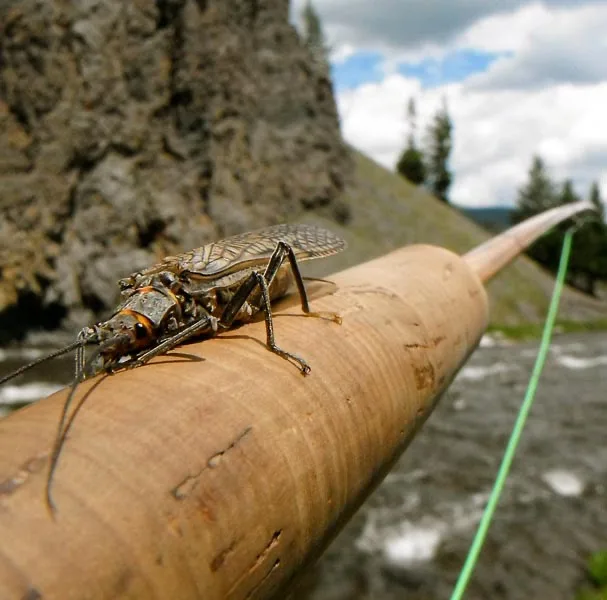Salmon Flys are HUGE Stoneflies. These Big Mac bites can be a challenge to cast and fish with. Our Montana rivers are showing off this amazing hatch now. As kids we used Sofa Pillows, and other imitations, to mimic these monster bugs. We called them “Battleships!”
The Salmon Fly hatch emerges in Montana’s western rivers first. The hatch migrates eastward as most of the trout watersheds get their turn. The Madison River has a wonderful hatch that many fly anglers target, but most trout waters support these large stones.
Years ago, I was fishing in the Yellowstone River. I was using large size 6 stonefly patterns. The fishing was great, and I was hooking up well. Suddenly I heard a guy crying out for help. He had hooked himself on a back cast. The fly was completely hooked into his left ear.
I came over to his rescue and asked if he wanted to wear the fly as an earring or have it removed. He wanted it out now, so he could tie it back on his leader. I grabbed my forceps and took a look. The hook was embedded below the barb in solidly stuck in the fatty part of the ear.
I took out an ice cube from my boat cooler and numbed the area. Without a warning, I used my forceps to push the hook point out. If I had jerked the hook out, to save the fly, it would have cost more blood and meat. I next made the hook barbless and quickly pulled the intact hook free. The guy laughed about he had never used a barbless hook before. We sanitized his wound with some whiskey from his flask. That’s how we roll in Montana.
Later that day at the Pine Creek boat ramp, I met another guy with a salmon fly stuck in his eyebrow. Dr. Montana Grant went to work and removed his eye bling with a minimum of pain and blood. He rewarded me with a cold Australian beer.
Casting big flies requires some Big Fly casting skills. You need a full-flexed back cast to load your fly rod for the forward push. Without loading the rod, your fly will come forward lower. This means head and face high.
To help with these unwanted hookups, try these tips
Use a stiffer rod. A stiffer rod will throw the fly stronger once loaded. Remember the back cast is where the power comes from.
Shorten your leader. It’s easier to control a shorter tippet than a 10-footer. You will also increase the cast’s accuracy. Your tippet can also be heavier to prevent snapping off your flies.
Shorten your cast. It’s easier to manage a shorter cast. Stalk the fish before making a longer cast.
Avoid using a dropper until you can handle just one large fly. A second tie on magnifies the risk of a back cast hooking.
Use hair imitations rather than foam ones. I find that flatter foam flies look great but tend to flutter when cast. They also twist and turn on the hook. Hair flies tend to be heavier and more streamlined. They plop more realistically onto the water as well.
Sharpen your hooks. A sharp hook comes out easier than a dull one.
Try using a bubble and a spinning rod where allowed. This approach is safer for beginners and kids.
Wear a huge hat. The fly will hit the large 360-degree brim before embedding into the wearer.
Wear polaroid fishing glasses. Keep the hooks out of your eyes.
Carry some Band-Aids, a cord, and some first aid instructions on how to remove/release an embedded fly or hook.
Montana Mountain men would always say farewell by saying, “Watch Yer Topknot!” This meant you needed to make sure that your pack animals load was properly secured. If Mountain Men were fly fishermen, they would say,
“Watch Yer Back cast!”
Montana Grant




